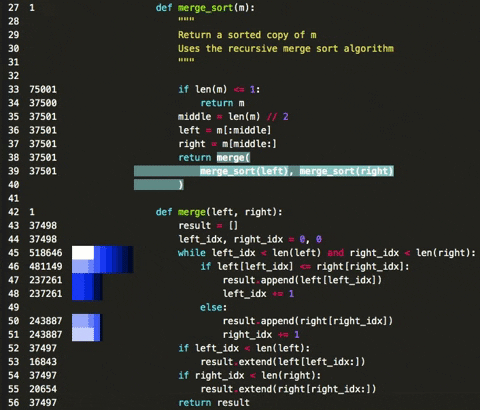2个有用的Python命令行下可视化、调试、分析工具
loguru - 打印日志(特别是异常的详细信息)
loguru本身是一个日志库,跟logging库差不多,但是它还支持更丰富的一些功能,其中一项就是它可以显示抛出异常时的调用栈和各参数值。
使用方法很简单,我们只用使用loguru.logger.catch装饰我们要显示详细异常信息的函数即可。
比如下面的例子里,我建立了两个函数,一个fun_raw不用装饰器,fun_catch使用装饰器。它们的作用都是调用basic函数。我这里之所以多搞出一层basic函数,是为了展示调用栈的返回效果。
from loguru import logger
my_list = [1, 2, 3]
my_dict = {
'a': 'b' }
def basic(a,b):
return a+b
def fun_raw(a, b):
t = basic(a,b)
return t
@logger.catch
def fun_catch(a, b):
t = basic(a,b)
return t
下面我们调用基本的函数,会得到普通的异常信息。
fun_raw(my_list, my_dict)
# 输出的异常信息如下:
---------------------------------------------------------------------------
TypeError
Traceback (most recent call last)
<ipython-input-5-339452031bfc> in <module>()
----> 1 fun_raw(my_list, my_dict)
<ipython-input-4-b6eabadbdba9> in fun_raw(a, b)
7
8 def fun_raw(a, b):
----> 9 t = basic(a,b)
10 return t
11
<ipython-input-4-b6eabadbdba9> in basic(a, b)
4
5 def basic(a,b):
----> 6 return a+b
7
8 def fun_raw(a, b):
TypeError: can only concatenate list (not "dict") to list
下面我们调用使用装饰器装饰后的函数,我们会得到包含参数值的详细调用栈信息。
fun_raw(my_list, my_dict)
# 输出的部分异常信息如下:
---------------------------------------------------------------------------
> File "" , line 1, in <module>
fun_catch(my_list, my_dict)
│ │ └ {
'a': 'b'}
│ └ [1, 2, 3]
└ <function fun_catch at 0x7f0e34b138c0>
File "" , line 14, in fun_catch
t = basic(a,b)
│ │ └ {
'a': 'b'}
│ └ [1, 2, 3]
└ <function basic at 0x7f0e5ac99050>
File "" , line 6, in basic
return a+b
│ └ {
'a': 'b'}
└ [1, 2, 3]
TypeError: can only concatenate list (not "dict") to list
项目主页:https://github.com/Delgan/loguru
安装方法:
pip install loguru
snoop - 打印执行情况
它可以显示每一行正在执行的代码,以及这一行代码的行号、变量值、返回值、执行时间。对于研究代码行为、分析异常原因非常有用,特别是使用jupyter的时候。
它的使用也非常容易,可以直接用@snoop装饰要分析的函数,或者使用with snoop:语法来包裹要分析的部分。
下面这个例子里,我实现了一个将一个数字转换成它的二进制表示的小函数。
import snoop
@snoop
def number2bits(number):
bits = []
while number:
number, remainder = divmod(number, 2)
bits.insert(0, remainder)
return bits
number2bits(5)
我们来分析它在参数值为5的时候的执行过程。
01:09:55.71 >>> Call to number2bits in File "" , line 4
01:09:55.71 ...... number = 5
01:09:55.71 4 | def number2bits(number):
01:09:55.71 5 | bits = []
01:09:55.71 6 | while number:
01:09:55.72 7 | number, remainder = divmod(number, 2)
01:09:55.72 .............. number = 2
01:09:55.72 .............. remainder = 1
01:09:55.72 8 | bits.insert(0, remainder)
01:09:55.72 .............. bits = [1]
01:09:55.72 .............. len(bits) = 1
01:09:55.72 6 | while number:
01:09:55.72 7 | number, remainder = divmod(number, 2)
01:09:55.73 .............. number = 1
01:09:55.73 .............. remainder = 0
01:09:55.73 8 | bits.insert(0, remainder)
01:09:55.73 .............. bits = [0, 1]
01:09:55.73 .............. len(bits) = 2
01:09:55.73 6 | while number:
01:09:55.73 7 | number, remainder = divmod(number, 2)
01:09:55.73 .............. number = 0
01:09:55.73 .............. remainder = 1
01:09:55.73 8 | bits.insert(0, remainder)
01:09:55.73 .............. bits = [1, 0, 1]
01:09:55.73 .............. len(bits) = 3
01:09:55.73 6 | while number:
01:09:55.74 9 | return bits
01:09:55.74 <<< Return value from number2bits: [1, 0, 1]
[1, 0, 1]
项目主页:https://github.com/alexmojaki/snoop
https://pypi.org/project/snoop/
它的功能很丰富,更多的功能可用参考项目主页。
安装方法:
pip install snoop
heartrate - 显示实时执行情况
它不是在命令行下直接显示的,但是功能也很强大,所以也介绍一下。它是snoop的作者在snoop的基础上开发的。它可用实时显示Python程序的运行情况。
运行下面的命令之后,它会在本地的9999端口开启一个web page。然后我们可以通过http://localhost:9999/打开,使用浏览器观察代码运行情况。当然这些都是可以改的。而且除了直接监视后续运行的代码,也可以指定特定文件。
import heartrate
heartrate.trace(browser=True)
下图是来自官方主页的效果动图,它实时显示了merge_sort算法在执行过程中各行代码的执行次数。我们可以把它当做一个profiler来用。

项目主页:https://github.com/alexmojaki/heartrate
安装方法:
pip install heartrate